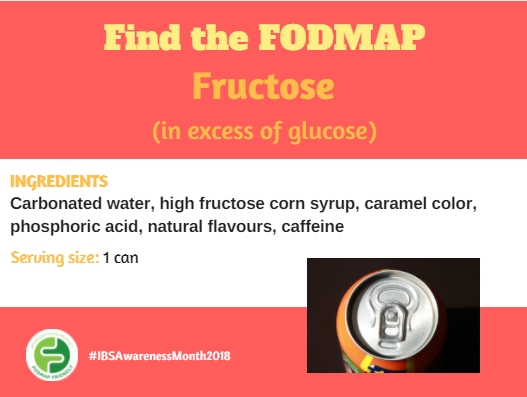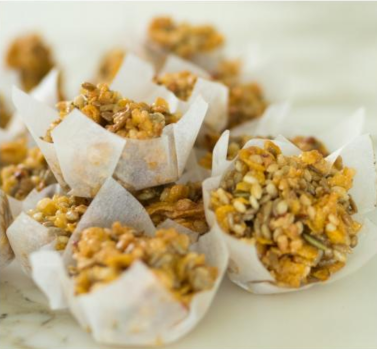Finding The Fructose: A Label Reading & Recipe Swap Guide For Beginners
Posted on April 18, 2018
Learning to Find Fructose: The Beginner’s Guide to Label-reading & Recipe Swapping
Now that you know all about ‘Fructose’, the ‘M’ for ‘Monosaccharide’ in the FODMAP acronym, you’re ready for part 2!
In this blog, we focus on finding high fructose ingredients within the ingredients lists of some common supermarket food items. We’ll also share an easy low fructose recipe with you that is also low FODMAP overall.
If you missed our previous blog about fructose malabsorption & intolerance, click here.
Can you find the Fructose?
Here is the ingredients list for a standard Apple & Blackcurrant Juice commonly found in a supermarket near you.
Can you spot the ingredient which contains high amounts of fructose?

How did you go?

The answer is ‘Reconstituted Fruit Juice’, the main ingredient in the product.
The ingredient present in the highest quantity in a food product is listed first in the ingredients list, so we know that in this particular example, reconstituted fruit juices, containing apple and black current juices, are present in the highest quantities per 250ml serve of the product.
Fructose is a Monosaccharide (a type of simple carbohydrate) which occurs naturally as free fructose in honey and certain fruits, including apples, pears and mangoes. Consumption of excess fructose can cause gastrointestinal symptoms such as bloating and altered gut motility in people with fructose intolerance. Click here to find the fructose content of a range of fruits.
Many bottled juices we see in supermarkets are made of reconstituted fruit juice which is produced from a fruit juice concentrate. Fruit juice concentrate condenses the fructose in standard fruit juice, often which contains excess fructose, especially juice of the ‘problem fruits’. It is important for people with fructose intolerance that they do not eliminate all fruits from the diet, because fruit contains vitamins, dietary fibre and other nutrients we need to maintain a healthy, balanced diet.
Rather, those affected should reduce intake of fruits or other foods that are high in excess fructose that trigger their symptoms, and replace them with alternatives that they tolerate better.
Examples of fruits that are low in fructose include blueberry, strawberry, kiwi and pineapple. You can find more low fructose fruit alternatives in the FODMAP Friendly App.
Another ingredients list – have a go!
This is the ingredient label of a soda.

Can you spot the ingredient that is high in fructose?

As the name suggests, high fructose corn syrup (HFCS) is a common source of fructose used to sweeten desserts, soda, and some other processed foods particularly in the USA. Consuming large serves of these products can trigger fructose malabsorption symptoms in people with fructose intolerance.
Corn syrup is different to high-fructose corn syrup because it contains mainly glucose instead of fructose. Therefore, don’t worry if you see corn syrup on ingredient labels, as it is low FODMAP!
Foods that are low in fructose can still be high in other FODMAPs!
It is important to note that not all low fructose foods are low FODMAP overall. If you need to avoid other FODMAPs such as fructans, GOS, lactose and sugar alcohols (sorbitol and mannitol), look for FODMAP Friendly Certified products.
The best way to identify FODMAP Friendly products while shopping online or in the supermarket, is to check the product packaging displays the green FODMAP Friendly Certification logo, shown below:

Cocofrio Dairy & Gluten Free Coconut Ice Cream
Cocofrio uses organic rice syrup in their ice-cream. Rice syrup (which is also called rice malt syrup) is considered to be an alternative to high-fructose corn syrup for people with fructose malabsorption. This is because it contains more glucose than fructose (hence a low fructose-to-glucose ratio).
Also, if you are missing mango and honey (high fructose foods), good news for you – Cocofrio Mango Ice-cream, Caramel Honey Macadamia Ice-cream and all other flavours are tested and Certified FODMAP Friendly, hence they are low in fructose (and all other FODMAPs)!
About Cocofrio’s range: https://cocofrio.com.au/
Low FODMAP Low Fructose ‘Honey Joys’
Honey is high in fructose but there are alternatives that we can use in recipes such as maple syrup and rice malt syrup.
Here is a recipe for ‘Honey Joys’ using rice malt syrup and new FODMAP Friendly Certified Nutty Almond Fruit Free Clusters from Food for Health!

Recipe serves: 24
Ingredients
90g butter
4 tbsp rice malt syrup
2 cups of Food for Health Nutty Almond Fruit Free Clusters
Method
- Preheat oven to 180 degrees. Line a 24-whole cupcake try with cupcake papers.
- Melt butter with rice malt syrup until frothy. Add clusters and mix well.
- Spoon mixture into cupcake cases. Place in oven and bake for 10 minutes.
- Allow to cool and serve
Recipe page 41 of Food For Health recipe e-book: LOVE LIFE: LOVE YOU.

Nutty Almond Fruit Free Clusters – Available in Coles from April 16th, 2018.
Looking for more from Food for Health?
Food For Health produce a range of FODMAP Friendly Certified products (hence low in fructose and all other FODMAPs) including mueslis, muesli bars and muesli pods.
And the exciting news from Food For Health is that Sea Salt & Caramel Fruit Free Bars and Coffee & Cacao Fruit Free Bars have just launched into Coles supermarkets this week!
They are the perfect FODMAP Friendly and gluten-free snacks to enjoy any time of day.
Don’t compromise the joy of eating while following a low FODMAP diet or low fructose diet!
It is recommended you consult an Accredited Practising Dietitian (Australia), or a Registered Dietitian (US, UK, etc.), in order to find out which specific FODMAPs, and what quantities you can tolerate; as well as what substitutes you can enjoy without compromising nutrition and taste.
Stay tuned
The focus of next week will be the ‘P’ of FODMAPs – Polyols.
We’ll explore the effects of polyols, particularly sorbitol and mannitol, on our gut, and what the substitutes are.
Thanks for reading!
Written by: Flora Cheung (APD, AN)
Edited by: Atlanta Miall-Shorten, (APD, AN, AccSD)
References
Amy F, Satish SCR. Dietary fructose intolerance, fructan intolerance and FODMAPs. Curr Gastroenterol Rep. 2014 January ; 16(1): 370
Shepherd SJ, Gibson PR. Fructose Malabsorption and Symptoms of Irritable Bowel Syndrome: Guidelines for Effective Dietary Management. J Am Diet Assoc. 2006 Oct;106(10):1631-9.

Eat with Confidence!









